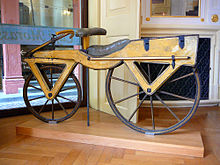This article is about the history of the reciprocating-type steam engine
The first recorded rudimentary steam engine was the aeolipile described by Hero of Alexandria in the 1st century AD.Starting in the 12th century, a number of steam-powered devices were experimented with or proposed. In 1712 Thomas Newcomen's atmospheric engine
became the first commercially successful engine using the principle of
the piston and cylinder, which was the fundamental type steam engine
used until the early 20th century.
During the industrial revolution, steam engines
started to replace water and wind power, and eventually became the
dominant source of power in the late 19th century and remaining so into
the early decades of the 20th century, when the more efficient steam
turbine and the internal combustion engine resulted in the rapid replacement of the steam engines. The steam turbine has become the most common method by which electrical power generators are driven.[2]
Investigations are being made into the practicalities of reviving the
reciprocating steam engine as the basis for a new wave of advanced steam technology
Early uses of steam poweR
The earliest known rudimentary steam engine and reaction steam turbine, the aeolipile, is described by a Greek mathematician and engineer named Hero of Alexandria (Heron) in 1st century Roman Egypt, as recorded in his manuscript Spiritalia seu Pneumatica. Steam ejected tangentially from nozzles caused a pivoted ball to rotate. Its thermal efficiency was low. This suggests that the conversion of steam pressure into mechanical movement was known in Roman Egypt in the 1st century. Hero also devised a machine that used air heated in an altar fire to displace a quantity of water from a closed vessel. The weight of the water was made to pull a hidden rope to operate temple doors. Some historians have conflated the two inventions to assert, incorrectly, that the aeolipile was capable of useful work.[citation needed]
According to William of Malmesbury, in 1125, Reims was home to a church that had an organ powered by air escaping from compression "by heated water", apparently designed and constructed by professor Gerbertus
Among the papers of Leonardo da Vinci dating to the late 15th century is the design for a steam-powered cannon called the Architonnerre which works by the sudden influx of hot water into a sealed red hot cannon
A rudimentary impact steam turbine was described in 1551 by Taqi al-Din, a philosopher, astronomer and engineer in 16th century Ottoman Egypt, who described a method for rotating a spit
by means of a jet of steam playing on rotary vanes around the periphery
of a wheel. A similar device for rotating a spit was also later
described by John Wilkins in 1648. These devices were then called "mills" but are now known as steam jacks. Another similar rudimentary steam turbine is shown by Giovanni Branca, an Italian engineer, in 1629 for turning a cylindrical escapement device that alternately lifted and let fall a pair of pestles working in mortars
The steam flow of these early steam turbines, however, was not
concentrated and most of its energy was dissipated in all directions.
This would have led to a great waste of energy and so they were never
seriously considered for industrial use.
In 1605 French mathematician Florence Rivault
in his treatise on artillery wrote on his discovery that water, if
confined in a bombshell and heated, would explode the shells.
In 1606, the Spaniard, Jerónimo de Ayanz y Beaumont
demonstrated and was granted a patent for a steam powered water pump.
The pump was successfully used to drain the inundated mines of Guadalcanal, Spain.
In 1663 Edward Somerset, 2nd Marquess of Worcester published designs for raising water between floors employing a similar principle to that of a coffee percolator.
His system was the first to separate the boiler from the pumping
action. Water was admitted into a reinforced barrel from a cistern, and
then a valve was opened to admit steam from a separate boiler. The
pressure built over the top of the water, driving it up a pipe.He installed his steam-powered device on the wall of the Great Tower at Raglan Castle
to supply water through the tower. The grooves in the wall where the
engine was installed were still to be seen in the 19th century. However,
no one was prepared to risk money for such a revolutionary concept, and
without backers the machine remained undeveloped
As the 18th century advanced, the call was for higher pressures; this
was strongly resisted by Watt who used the monopoly his patent gave him
to prevent others from building high-pressure engines and using them in
vehicles. He mistrusted the materials' resistance and the boiler
technology of the day.
The important advantages of high pressure engines were:
- They could be made much smaller than previously for a given power output. There was thus the potential for steam engines to be developed that were small and powerful enough to propel themselves and other objects. As a result, steam power for transportation now became a practicality in the form of ships and land vehicles, which revolutionised cargo businesses, travel, military strategy, and essentially every aspect of society.
- Because of their smaller size, they were much less expensive.
- They did not require the significant quantities of condenser cooling water needed by atmospheric engines.
- They could be designed to run at higher speeds, making them more suitable for powering machinery.
The disadvantages were:
- In the low pressure range they were less efficient than condensing engines, especially if steam was not used expansively.
- They were more susceptible to boiler explosions













